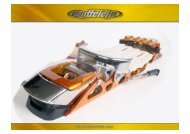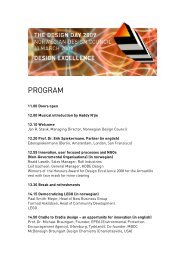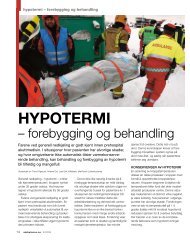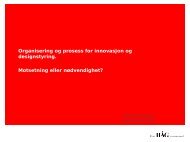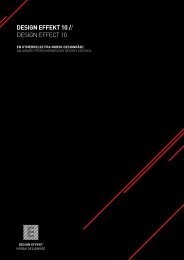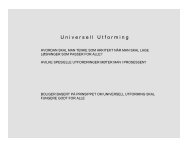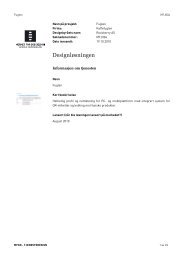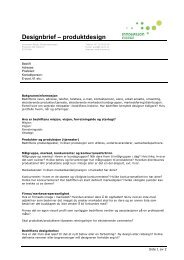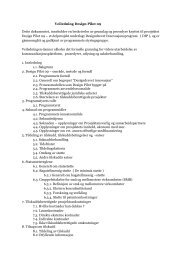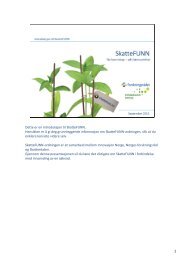100% Norway
100% Norway
100% Norway
- No tags were found...
You also want an ePaper? Increase the reach of your titles
YUMPU automatically turns print PDFs into web optimized ePapers that Google loves.
<strong>Norway</strong> may be primarily known for its scenery, fish and oilresources, yet the country also has gained an important roleon the international design scene. In fact, a Norwegian designwave is taking place, fuelled by the creativity and boldness ofour young designers, and the innovative attitude of ourmanufacturing industry.<strong>100%</strong> <strong>Norway</strong> is a showcase of this creativity, boldness andattitude. It is also a joint effort, made possible by the designersand industry, as well as its official partners the Ministry of Tradeand Industry, the Ministry of Foreign Affairs, the Royal NorwegianEmbassy in London, Innovation <strong>Norway</strong>, the Norwegian DesignCouncil, and the Association of Norwegian Furniture Industry.The exhibition shows that our designers are not limited bythe Scandinavian design heritage; rather they are inspired by it.Norwegian design is characterised by its modesty, simplicity andpurity – representing the spirit of <strong>Norway</strong>. The observant spectatorwill also find playfulness and beauty in the lines and shapeswhether the piece is a chair, a vase or an electric lamp.Continues overleaf 04 05
Norwegian modesty shapes furniture that is laid-back andcalming. Norwegian simplicity ensures pieces of design thatare functional as well as beautiful. Norwegian purity grantshigh quality pieces that to a large extent are made from naturalmaterials such as wood, wool and leather. The Norwegiandesign industry aims at being sustainable – in its production andits products.<strong>100%</strong> <strong>Norway</strong> covers different genres within interior productsand design. Furniture plays a leading role, but visitors will findcrisp glass and beautiful, often humorous shapes, in lamps,ceramics and carpets among other products. The works oftoday’s young designers are clearly versatile. Joint exhibitions like<strong>100%</strong> <strong>Norway</strong> inspire enterprises and designers to cooperatewith regard to export, marketing and design. The ultimate goal isto tell the story of our country and to provide foreign markets withNorwegian beauty and pieces of our culture.Welcome to <strong>100%</strong> <strong>Norway</strong> 2009!Sylvia BrustadMinister of Trade and Industry0607
<strong>Norway</strong> is well known amongst the well travelled as havingsome of the most beautiful scenery in the world. It’s a countryfamous with both fishmongers and financiers as being one of thewealthiest. Socialists and polititians point up to this exemplarynation for its equal opportunities policies and its just democracy:in <strong>Norway</strong> parliament is made up of more than 40% women,while in April this year unemployment figures had shrunk to lowerthan 3%.Professional opinions aside, however, this country remainsone of the world’s best kept secrets. And never more so than inthe fields of design and innovation. The reason? Ego is not thenational export: if you want to discover what <strong>Norway</strong> has to offer,you have to ask.This has been the predominant challenge in curating thisyear’s <strong>100%</strong> <strong>Norway</strong>. For several key reasons there is no formalapplication process to take part in the exhibition, and insteadthe selection of designs on display has been sought out duringa rigorous research process. Co-curator Benedicte Sunde andmyself have travelled, again, across the breadth and considerablelength of this fabulous country, visiting everyone frommanufacturers to designer makers, design schools and ateliers inorder to find the newest and best. Our politics are neutral and ourpreferences tend only towards great design.While it has consistently been an inspiring and surprisingprocess, this year – my fourth in this role – has been morerewarding in terms of talent than ever. <strong>Norway</strong>’s manufacturers’renewed faith in home grown contemporary design is very clearlynow bearing fruit: after a decade of investment and a generationof world-class designers willing to make a point of their origins,Norwegian design is now ripe for the picking.Henrietta ThompsonCurator, <strong>100%</strong> <strong>Norway</strong>08 09
Fjord FocusWritten by Clare DowdyFirst published in Wallpaper*, October 2009Fora Form’s eye-catching range of furniture,including the Johan Verde-designed bright-red‘Loop’ armchair, is shot in one of <strong>Norway</strong>’s mostbeautiful valleys, a short trip from Fora Form’sfactory in Ørsta.A hundred years ago, in an inhospitable corner of <strong>Norway</strong>, the seedsof a furniture revolution were sown. It all began in Sunnmøre, theregion around the city of Ålesund. A mountainous area more islandsthan mainland, Sunnmøre is interspersed with fjords and shroudedin darkness for much of the winter. Here, farmers were becomingdisillusioned with scratching a living from the difficult terrain, and weredesperately looking for new ways to generate an income.Already adept craftsmen through necessity, the local people alsohad an entrepreneurial streak. They quickly made use of the localthick green pine forests that surrounded them. One by one, smallfurniture workshops started to spring up along the fjords’ banks.Today, there are more than a hundred furniture and componentsmanufacturers – many of them still family-run.There are plenty of examples of this collective history. One suchis Variér Furniture, established in 1932 by Georg Stokke near theGeiranger fjord, and perhaps best known for its classic (and muchcopied) ‘Planet’ chair of 1965, as well as Olav Eldøy’s iconic‘Date’ chair.Another local institution is the 69-year-old LK Hjelle. Locatedslightly further north in Sykkylven, the company has been quietlychampioning the covetable sofa designs of <strong>Norway</strong> Says, amongothers, for the last decade.Stordal, known for its leather chairs and sofas, was foundedin the 1930s by the current managing director’s grandfather. ‘Mygrandfather came from a mountain farm, and he was used to makingeverything by hand. In this area, we’re known for creating our ownstuff, because it’s tough to live here,’ explains Ole Håvard Stavseng.And Stordal is still very much a family affair. The design of thecurrent factory building and the artwork featured inside were made10 Photo: Åke E:son Lindman11
y two of Stavseng’s uncles. And while we chat about thebusiness in a meeting room, his mother offers us some of herhome-made waffles.Ekornes, on the other hand, has its roots in furniture components.It kicked off in 1934, making springs for neighbouring manufacturers.From there, it turned its hand to mattresses, before progressingfrom beds and sofa-beds to sofas. It hit upon its ‘Stressless’reclinable seating range in 1971 and has stuck to its guns ever since.Now one in every four households in <strong>Norway</strong> has a ‘Stressless’of some description, according to Arve Ekornes, director ofproduct development.All these businesses, along with contract furniture company ForaForm – which claims to be the oldest furniture factory in the country– have settings which are rarely associated with industry; they all siton the edge of stunning fjords with forest-covered mountainsides.Stavseng at Stordal is even closer to nature: a part of his building’sroof terrace is out of bounds at the moment, as a small local seabirdhas made its nest up there.This being Scandinavia, the buzzwords are quality, beauty andfunctionality, and Stordal, Fora Form and Ekornes come at this fromdifferent angles. For Stordal, the high-quality materials and making,with its leather coming from Italy and all its seating being handcraftedin its 75-strong factory. At Fora Form, the form is deliveredby a raft of external designers, who give the company current andback catalogues strewn with design classics. And Ekornes is aboutfunctionality, patenting a number of cunning devices which contributeto Arve Ekornes’s assertion: ‘Our most important value is comfort.’In fact, he would not be offended to be described as obsessedwith the comfort factors of ‘Stressless’. After all, he’s been living thebrand since he joined the company as an apprentice in the machinedepartment 25 years ago. He can’t bear sitting on any other sort ofseating, and Ekornes’s 1,500 staff seem to agree. Some of themenjoy reclining in a ‘Stressless’ after lunch, their workmen’s bootsperched on an accompanying ottoman.Perhaps unsurprisingly, Ekornes keeps its design cards close toits chest. It spends one per cent of its NOK2.7bn (£300m) turnoveron research and development, and puts all the design of its newranges in the hands of its four-strong in-house design team. They’reled by senior designer Jan Lade, who had freelanced for many ofthe area’s furniture manufacturers before joining Ekornes around tenyears ago. ‘We don’t use external designers, because we don’t wantto outsource the brand. Our designers know our market, historyand philosophy, and that knowledge should be in the heart of thecompany,’ says Arve Ekornes. And to avoid his designers gettingstale, he packs them off to the furniture fairs for a bit of inspiration: ‘Ihave to make sure my designers see how the design worldis changing.’Both Fora Form and Variér have taken the opposite approach.Conveniently, there’s plenty of Norwegian design talent to drawfrom. Along with Tveit & Tornøe, there are Bergen’s Circus Designand Oslo’s StokkeAustad, whose latest pieces include a ‘Lobby’chair for Casamania and a dining table and bench for south <strong>Norway</strong>manufacturer Nora. One of Variér’s latest pieces, the ‘Penguin’ chair,draws on the design skill of Peter Opsvik in Oslo, while Fora FormStressless’ recliners in production at12 Ekornes’s factory in Ikornnes, <strong>Norway</strong>.Photos: Åke E:son Lindman13
has put all its design in the hands of outside creatives since the1950s. And in aesthetic terms, at least, the move has paid off.‘From the late 1980s, we’ve earned more design awards than anyother Norwegian company,’ says managing director Gunnar Hareide.Fora Form’s design manager, Arild Bakke, is the one in chargeof hunting down the next big thing at colleges such as the BergenNational Academy of the Arts. That’s how the ‘Copenhagen’ chaircame about: it was created by Lars Tornøe of Tveit & Tornøe for hismasters degree. Tornøe, along with design partner Atle Tveit, hassince designed the ‘Clint’ conference chair, and the duo are nowin the process of creating a table system. ‘We want to havea balance between new and old designers,’ says Hareide.Bakke also spots talent at the fairs, and although Fora Formhas considered approaching designers from further afield, he’sconcentrating on Scandinavian designers for the moment. ‘Wewant to stick to the upper side of modern and to be experimentalsometimes,’ explains Hareide.LK Hjelle, on the other hand, has been happy to draw on non-Scandinavian design talent. As well as its long-running relationshipwith <strong>Norway</strong> Says (now defunct), it has more recently joined forceswith French designer Inga Sempé, who is behind their comfy‘Coussin’ sofa. Fora Form’s rich archive is something that thecompany likes to revisit every six years or so, when it will pair upa new launch with a relaunch of one of its classics. For example,Johan Verde’s ‘Loop’ armchair hit the market in 2002 alongside thespherical ‘Planet’, which originally appeared in 1965, courtesy of thegrand old man of Norwegian design, Sven Ivar Dysthe.Of course, the 1960s was when the Scandinavian style hit theworld stage, and Ekornes and Stordal also have some classicpieces from those halcyon days. But neither company is in a rush toreissue. Arve Ekornes, for one, is keener to focus on his big sellers,such as the 1995 ‘Vegas’ recliner, his most popular product whoseNOK300m (£33m) annual sales are still growing.While Stordal doesn’t make great play of the external designersthat are introduced to complement the in-house team, thecompany’s first Norwegian Design Council award was for ‘Rektangel’,a stylish sofa suite designed in 1970 by a young gun straight out ofcollege. However, ‘it’s not top of my mind to reissue it, but behind myear,’ says Stavseng, using a Norwegian colloquialism.For all three companies, the future is about increasing sales,and that in <strong>Norway</strong> tends to mean overseas sales. Stordal alreadyexports 50 per cent of its wares to France, Belgium, Switzerland andGermany. Fora Form is keen to crack the US with its ‘Shell’ chair byKomplot Design, as well as a new table system, sofa and conferencechair. As for ‘Stressless’ evangelist Arve Ekornes, he is keeping mumabout developments for 2010, but reveals in hushed tones that‘Ekornes will take the comfort story to new levels’.But this is not all about long-standing players. Fjordfiesta, setup in 2001 in the small town of Molde, is already making waveswith its ‘Scandia Junior’ stackable chair. It seems this cocktail offurniture and fjords is working well for a small but significant pocket ofScandinavian design.Stordal’s simple, functional and beautiful rangeof sofas, stools, tables and reclining chairs isphotographed in the fjord village of Dyrkornin <strong>Norway</strong>.Photo: Åke E:son Lindman14 15
With age comesbeauty...Northern Lights over the ‘hjeller’, the timberstructure used to dry fish, in Svolvær, Lofoten, inNorthern <strong>Norway</strong>.Photo: Stockshots.no/Innovation <strong>Norway</strong>Jonas Stokke and Øystein Austad have been exhibiting at<strong>100%</strong> <strong>Norway</strong> since they first started working together in 2006– then just one year into their studies but already showingserious promise. These days StokkeAustad is operating as anincreasingly well-reputed professional company and this year theyhave been entrusted the role of official exhibition designers.That the pair was making waves on the international exhibitioncircuit while studying in their first year at the Oslo School ofArchitecture and Design suggests that StokkeAustad might bequite ambitious. They have doubled in size in the last year byteaming up with Geir Fredriksen and Joachim Levin to help themdevelop the business, and with an already strong if fledglingbrand Stokke Austad now can boast several items in production:the Lobby Chair for Casamania, and a large oak dining table forNorwegian manufacturer Nora (see page 40) are just two that arewell worth seeking out.Much of their success springs from the strong sense of supportthat exists on the contemporary Norwegian design scene. Austadonce completed an internship at the well-known (now disbanded)champions of which, <strong>Norway</strong> Says, and when StokkeAustad setup shop independently the former wasted no time deferring work,publicity and recommendations in their direction. The communityspirit is something that Jonas and Øystein hope to help nuturethemselves as they become more established too.www.stokkeaustad.com16 www.kebony.com17
The Norwegian stand at <strong>100%</strong> <strong>Norway</strong> in Londonhas been designed by StokkeAustad and the timbersupplied by Kebony.Fittingly, it is in a collaboration with Norwegian companyKebony that Stokke Austad is producing the exhibition designfor <strong>100%</strong> <strong>Norway</strong> this year. A new wood which has beentreated using biowaste from the sugar industry, Kebony istouted as being as hardwearing as teak, maintenance free,and environmentally sound.The stand takes the form of a traditional ‘Hjeller’, an A-frametimber architecture traditionally built for drying fish. “Back in thedays you could see them more or less all along the Norwegiancoast line,” says Øystein. “These days modern new techniquesmean there are fewer of them but there are still plenty dottedaround the North of <strong>Norway</strong>, especially in Lofoten.” Apparentlythere is also an island outside Svolvær called Grisøya where,although there is no human settlement, it’s possible to see manyFiske Hjeller still in use.The structure will also be accessorised with a bespoke newrange of Kebony furniture by the designers, including podiumsand display cases as well as a reception desk.One of the qualities of Kebony that the designers wantedto exploit was its durability. Gaining an attractive patina withweathering the wood changes colour from brown to grey, soStokke Austad produced the stand some months before it wouldbe needed at the exhibition and left it outside to be exposed tothe elements.The stand design will show how Kebony, like many hardwoods,improves as it ages. So too, it is quite apparent, have its designers.www.stokkeaustad.com18 www.kebony.com19
Aksel HanssonWhen Aksel Hansson designed the original Aksel chair in 1938he could only have dreamed that over 70 years later his designwould have spawned a thriving family business and achievedsuch widespread critical acclaim, not to mention the royal seal ofapproval (the Queen of <strong>Norway</strong> visited their factory in the southwest of <strong>Norway</strong> in 2001).The simple household chair, made from natural pine andupholstered by hand with seagrass, is arguably one of the mosticonic Norwegian designs in production. Indeed it was officiallyrecognised this year as such by the Norwegian Design Councilwho gave it the prestigious Classic Award Prize.The fine wood is carefully selected with respect for theenvironment and the chairs are built to last, and suitable for anylifestyle and complimentary to many decors. For the last 20 yearsAksel Hansson’s daughter Lise has been running the company,and she is herself an expert on weaving the seagrass seats.Aksel chair, designed by Aksel Hansson andmanufactured by Aksel Hansson.20 www.aksel.no21
Anne HaavindAnne is a practising glass, graphic and visual artist, with asignature style dominated by large, functional shapes andincredible colours. “I’m fascinated by the possibilities andchallenges related to working with glass,” she says. “I run thecompany single-handedly and I wish to keep the business smalland keep producing exclusive merchandise.”Demand for her designs from both Norwegian and internationalbuyers has risen markedly during and after her previousappearances at <strong>100%</strong> <strong>Norway</strong>. This has in turn led to large designcontracts such as an eight metre tall chandelier at a new mosquein Oslo, commissioned by Pride Architects.Anne never travels anywhere without her sketchbook. Vitalfor recording her inspirations, she also uses her drawings tocommunicate to her glass blowers in the Czech Republic exactlywhat it is she intends when it comes to making the final pieces.Working hard to attain the perfect dimensions and hypnoticoptical forms with the transparency, cuts and colour as heronly devices, the end results are always instantly recognisable.The influences of the Norwegian landscape shine through inAnne’s pieces, and she lists the glaciers, reflective light and themountains as being among her inspirations. Anne describes herpieces as “Good forms that are beautiful in their own right butwhich also have a functionality.”XXL vase, designed and manufactured byAnne Haavind.22 www.annehaavind.com23
Biri TapetThe traditional wall covering, made from straw and hung on wallsfor the birds to be fed during winter, attracted the attention of twoarchitects in 1938 who commissioned Klare Schlee to replicateit for the Oslo Town Hall project they were working on and so thecompany was founded.Biri Tapet has since become something of a family affair andtoday Schlee’s granddaughter is in charge of the company. Thewall covering is still made by hand on the original farm in Biri, twohours from Oslo, at a production speed of 0.5 meter per hour.<strong>Norway</strong> Says designed the new wall covering Gangar for thecompany to mark its 70th anniversary. “Different colours canbe developed depending on the colour of the weaving thread,and the ratio of straw to thread used,” explains designer TorbjørnAnderssen. “We organised the woven fabric in graded patterns,resembling the shadows that occur on cylindrical shapes such asstraws or tree trunks.” The colour palette is based on the differentcolours found in the natural straw.Gangar wall coverings, designed by <strong>Norway</strong> Saysand manufactured by Biri Tapet.Photo: Arild Kristiansen24 www.biritapet.no25
Cathrine KullbergCathrine Kullberg’s lampshades depict Norwegian forest scenesdelicately cut into birch veneer. The fine workmanship and theevocative effect produced as the light shines through the shadeshas won Kullberg many fans – including Oslo’s luxury departmentstore Steen & Strom, who recently commissioned a 100sq minstallation from the designer for their top-floor restaurant.Cathrine studied at Central Saint Martin’s College of Art andDesign in London where – after being inspired by guest lecturerThomas Heatherwick, she joined his studio as project designer andproject manager. Back in Oslo she continued as project managerat Norsk Form, an information and project-based institution thatworks with design, architecture and urban area planning.The collection Norwegian Forest Lights is made by a varied teamof manufacturers; Cathrine Kullberg as designer along with a smallcompany usually making airplane model kits doing the delicatelaser cutting, and a small workshop in Sweden making the metalframes. The parts are assembled in Kullberg’s Oslo studio usingseams of natural leather lace.There is a long tradition in Scandinavian craft to use these thinstrips of wood, and in the 1950s, 60s, and 70s it was used forlighting. Now, the Norwegian Forest Lights represent a new takeon tradition.Norwegian Forrest lamp, designed andmanufactured by Cathrine Kullberg.26 www.cathrinekullberg.com27
FjordfiestaFjordfiesta, based in the city of Molde on <strong>Norway</strong>’s west coast,returns to <strong>100%</strong> <strong>Norway</strong> for yet another year. This time theybring the iconic Hans Brattrud Scandia chair from the 1950s,relaunched in a stackable version available in a range of colours.The Scandia chair, sold at auctions and vintage stores aswell as leading interior chains around world, is made using highfrequency lamination, a revolutionary technique back in 1957when the chair was launched. Brattrud was also awarded theKing of <strong>Norway</strong>’s medal of merit as a furniture designer. “Webelieve these chairs to be some of the few Scandinavian furnitureclassics strong enough to withstand the weight of time,” saysthe manufacturer.Not a company to stand still simply because it produces oneof the best-loved Scandinavian design classics on the market,Scandia has also been working with contemporary design team<strong>Norway</strong> Says. The result of the collaboration is the Nordica table,which in London will be shown in stained black oak.Fjordfiesta aims to be certified for environment friendlyproduction within 2009, while for the future, the company is keento continue combining continental elegance with Scandinaviansimplicity to ever more successful ends.Scandia Stackable chair, designed byHans Brattrud and manufactured by Fjordfiesta.28 www.fjordfiesta.com29
Fora FormFora Form was founded in 1929 and is one of many furniturecompanies on <strong>Norway</strong>’s west coast that have becomecornerstone businesses in their local communities. Workingwith a range of designers, a great focus is placed on aestheticsand innovation in their furniture designs. Perhaps influenced bythe stunning landscape that surrounds the factory, they stronglybelieve that the single most critical factor in relation to preservingthe environment is the development of products with a long life.City was designed in 1954 by Øivind Iversen for his Master’sthesis at the National College of Art and Design, and it was thefirst chair manufactured in <strong>Norway</strong> to be based on laminationtechnology. A precursor to Fritz Hansen’s Seven chair, which waslaunched a year later, City was astonishingly popular. Fora Formrelaunched the chair in its exact original form in 2007, a few yearsafter it made a star appearance in Australian pop star NatalieImbruglia’s hit video ‘Torn’.Complementing the plethora of classic designs in its range,Fora Form also works with up and coming Norwegian talents. In<strong>100%</strong> <strong>Norway</strong> the company will launch the Clint chair (so calledbecause it was inspired by Clint Eastwood’s cowboy hat) byBergen-based duo Tveit&Tornøe.Left: Clint chair, designed by Tveit&Tornøe andmanufactured by Fora Form.Right: Copenhagen chair, designed byLars Tornøe and manufactured by Fora Form.30 www.foraform.com31
HÅGLeft: Futu chair, designed by HÅG Design Studioand manufactured by HÅGRight: Sideways chair, designed by FormelIndustridesign and manufactured by HÅG.HÅG, a manufacturer of task and meeting room chairs since1943, has long put design and sustainability at the top of theiragenda and even used recycled bottle caps to make the backand seat of one of their products.Setting out on a mission to define the office chair of the future,HÅG recently invited three thinkers, two technicians, threedrafters and a couple of creatives to meet and brainstorm withHÅG’s product development team during a week-long sessionat a design studio in the Swedish forests. The result was a setof concepts and drafts for three new chairs, all based on a newdesign platform.One of these chairs is the HÅG Futu which is showing forthe first time in London at <strong>100%</strong> <strong>Norway</strong>. As its design concept‘Simple surface, complex core’ reveals, HÅG Futu is a fullyfunctional task chair with a streamlined and elegant design. Theadvanced interior is based on HÅG’s new inBalance technology,and the streamlined exterior is stripped for everything that disturbsits clean visual expression. HÅG Futu is manufactured using aminimum of resources; only a total of seven different materialtypes have been used including the fabric, none of which areenvironmentally harmful.Also showing in London will be the HÅG Sideways, a meetingroom chair developed for open and active communication.Studies show that we spend an equal amount of time in meetingsand workshops as at our desks, which often force us to sit witha sideway focus during meetings. However, Sideways’ large,comfortable seat has no restricted seating direction allowingthe user’s sitting radius to be increased to 180° as and whenis convenient.32 www.hag-uk.co.uk33
KebonyUsing Norwegian-developed technology, Kebony is a newmaterials company established with the aim of providing analternative to rainforest timber.Rainforest timber and deforestation have attracted a lot ofmedia attention in recent years, with the Norwegian governmentpromising investment of NOK 15 billion over a period of five yearsas a protective measure.Kebony uses a liquid bio waste from sugar production to“upgrade” the properties of sustainable Nordic timber such aspine, beech and maple. “Kebony is very durable and strongand it is highly resistant to rot. It can withstand harsh climatesand is ideal for both indoor and outdoor use,” says director ofmarketing Jan T. Nielsen. Suitable for decking, wooden piers,indoor flooring, cladding, wooden roofing and other constructionmaterials, it also has a potential for use in windows, furniture andboat decks.Fast gaining popularity in <strong>Norway</strong>, Kebony has already beensuccessfully specified in the new Carl Berner and Nationalteateretunderground stations in Oslo, the Estatia hotels (Kragerø, Norefjell,Trysil), the restaurant Le Canard, Marine Harvest, Pilestredet Park,and several schools and kindergartens.A new NOK 150million factory is scheduled for completion thisautumn, so that besides being an alternative to tropical timber,the product also means new industrial activity and new jobs in asustainable industry.Kebony has proved popular in new buildings across<strong>Norway</strong>, including this school in Porsgrunn.34 www.kebony.com35
KjerstiJohannessenGlass artist Kjersti Johannessen, returning to <strong>100%</strong> <strong>Norway</strong> forthe second consecutive year, works with both blown and cutglass. “I believe that it is easy to recognise a certain signaturein my design,” she says. “But I’m open to new ideas that requireother techniques and that challenges the ways I work.”Having founded her company in 2005 after a decade ofeducation and practical experience, Kjersti is now securelyin the top tier of <strong>Norway</strong>’s small but booming community ofinternationally respected glass artists. Kjersti’s work graces manynotable lobbies and living rooms, including those of Her Majestythe Queen of <strong>Norway</strong>. The artist has just finished a solo exhibitionat Kunstnerforbundet in Oslo and is also working on a project withglass art group Dynamo for an exhibition in Berlin next year.Johannessen explains that her aesthetic approach andreasoning have evolved from several years in art school. “Glass isa material that challenges me both technically and intellectually –by pursuing new ideas through the design process,” she says. “Aconstant issue that preoccupies me in my work is the borderlinebetween art, craftsmanship and design.”Contemplating glass sculpture, designed andmanufactured by Kjersti Johannessen.Photo: Kjell Brustad36 www.kjerstijohannessen.com37
LK HjelleDesigned by <strong>Norway</strong> Says and manufactured by LK Hjelle, theDuo sofa explores a little considered area in furniture design –acoustics. Created to provide the user with the option of extraprivacy and calm in noisy environments such as bars, lobbies,and other contract settings, the sides and back fold down or zipup in various configurations.<strong>Norway</strong> Says has been a leading force in the Norwegian designwave for the past decade. Originally an exhibition project from2000, the trio has since been designing furniture, interiors andproducts for both Norwegian and international manufacturers,and won scores of design awards. Although the trio has recentlydecided to split, allowing the designers to devote more timeto individual projects, their designs live on. <strong>Norway</strong> Says andmanufacturer LK Hjelle launched their first joint collection in 2004,and many of their joint projects are now deemed iconic.Like so many of the other furniture manufacturers based on<strong>Norway</strong>’s west coast, LK Hjelle is still a family business. Run todayby the founder’s grandson, it was first started in the basementof Lars Karl Hjelle’s home in 1940, but soon grew into a largerbusiness. Along with always implementing the latest manufacturingtechniques, the company says their craftsmen are an importantresource, passing on their expertise from generation to generation.Duo sofa and Day table, designed by <strong>Norway</strong> Saysand Hallgeir Homstvedt Prod,and manufacturedby LK Hjelle.38 www.hjelle.no39
NORA of <strong>Norway</strong>NORA of <strong>Norway</strong> debuted their first collection at last year’s<strong>100%</strong> <strong>Norway</strong>, and their second outing shows the youngcompany to be staying true to their manifesto, using materialshonestly, manufacturing locally and making sure sustainability isalways paramount.You’d be hard pushed to find a more honest, accomplisheduse of materials than the NORA dining table and occasionalbenches by StokkeAustad. The solid ash and oak design is soclean in its purity it seems a shame to put anything on it but theidea is that you use it for life and any wear and tear will tell a story.NORA of <strong>Norway</strong> was conceived with the intention of offeringcontemporary Norwegian designers the opportunity to get theirbest designs out on the market. The company is situated in Risør,a little town in the south of <strong>Norway</strong> which boasts a long traditionof craft and furniture traditions. Manufacturing all their productsin <strong>Norway</strong>, and sourcing Norwegian materials where possible,NORA’s aim is also to challenge popular conceptions of Nordicdesign and, says founder Ivar Grødal, to “apply another dimensionto the objects”.NORA dining table and benches, designed byStokkeAustad and manufactured byNORA of <strong>Norway</strong>.40 www.noraofnorway.no41
Northern LightingIn a country where some regions never see the sun rise abovethe horizon during the winter months, and where natural lightphenomena such as the midnight sun and the northern lightshave fascinated astrologists for centuries, it follows that lightingwould be a central concern to Norwegians.With this as the main inspiration, Northern Lighting was set upfour years ago. The company now boasts 16 designers and designteams on its books and several impressive commercial successstories – four of which are on show at <strong>100%</strong> <strong>Norway</strong> 2009. “Wework with both up-and-coming talents and recognised designers,”explains founder Ove Rogne. “Despite their different levels ofexperience, they all have one thing in common: they are fiery soulswho are fascinated by the mood-creating possibilities of light.”Dokka, a small pendant light, was designed in 1954 by oneof Scandinavia’s leading post-war interior architects Birger Dahl.Dahl believed light object should always reach complete harmonywith its surrounding humans and architecture, and Dokka, themanifestation of this ideal, was the first Norwegian lamp ever to beawarded the highly regarded Golden Medal at the Milan Triennale.A popular reissue of an iconic classic, Northern Lighting has takencare to make as few changes as possible to the original design.Left: Diva lamp, designed by Thomas Egset andPeter Natedal, manufactured by Northern Lighting.Right: Bender lamp, designed by Morten Kildahland manufactured by Northern Lighting.42 www.northernlighting.no43
Diva, a wood laminated floor and pendant light sculpture, ismaking its global launch at the exhibition this year. Its two youngdesigners, Thomas K Efset and Peter Natedal, who both hail fromfamilies with long traditions in the furniture industry, created thestriking contemporary lamp with a considerable nod to the proudNorwegian heritage of wood lamination craftsmanship.Seed, designed by Hedda Braathen is a wall-mounted readinglamp fitted with an interchangeable cotton cover making it possibleto match it conveniently to the bedspread as well as the mood.Finally, Bender by young designer Morten Kildahl is a largefloorlamp with an oversized shade element and lots of personality.Left: Dokka lamp, designed by Birger Dahl andmanufactured by Northern Lighting.Right: Seed lamp, designed by Hedda Braathen,and manufactured by Northern Lighting.44 www.northernlighting.no45
PermafrostPermafrost is a design studio consisting of four Norwegianindustrial designers: Tore Vinje Brustad, Eivind Halseth, OskarJohansen, and Andreas Murray. Having met and started workingtogether – not to mention winning numerous awards – whilestudying at the Oslo School of Architecture, they establishedPermafrost as soon as they graduated.Permafrost began exhibiting their wares at trade fairs andexhibitions almost immediately and began receiving requests frompeople wanting to buy their designs. As a direct result of this theydecided to manufacture their products in-house with a series oflimited edition lines called “Stories by Permafrost”.“We always strive to maintain a signature of simple, functionalsolutions with a strong personality,” says Brustad. The first threereleases from the “Stories by Permafrost” collection, for example,were the woollen rugs, Silence, which sees the footprints of asnow rabbit embossed into the white pile, Giant Leap (the samebut with an astonaut’s boot impressions) and John Deere, a rugwith a tyre track across it, now available in green (gras) and brown(mud). Launching at <strong>100%</strong> <strong>Norway</strong> 2009 is Bear Hug – a series ofEscher-style tessellating polar bears.Left: Giant Leap rug, designed by Permafrostand manufactured by Stories by Permafrost.Right: Silence rug, designed by Permafrostand manufactured by Stories by Permafrost.46 www.permafrost.no47
Petter SkogstadArmed with impressive professionalism as well as consistentlygreat design skills, Oslo based masters student Petter Skogstad,24, is one young Norwegian to watch. Having already wowedseveral big manufacturers with his concept designs at the SaloneSatellite exhibition in Milan earlier this year, he has been furtherrewarded with his own dedicated area at <strong>100%</strong> <strong>Norway</strong> this year.Petter’s mission statement is simple: “I want to make beautifulproducts to use in everyday situations.” They combine aScandinavian sensibility – a clarity of concept and purity of form– with quite a Japanese approach to development, which is mostlikely why they seem more grown-up than student designs. “Iusually start with a very far-fetched idea and then spend agesrefining it until I feel I’ve reached the very essence of the conceptand the product is as functional as it can possibly be.”The Hay sofa is a modular sofa system consisting of rectangles,exactly the same dimensions as Norwegian hay bales, which canbe put together in any number of ways. Other prototypes includehis elegant Disko floor lamp, that doubles as a side table.Hay sofa, Soft tables, Body mirror and Disko floorlamp, all designed by Petter Skogstad48 www.petterskogstad.com49
Sara Skotte“I am inspired by functionality, quirky details, nature and the lifesurrounding me,” explains young ceramics designer Sara Skotte.Sara’s products are characterised by simple, clean lines withsubtle details that have a functioning aspect as well as beingdecorative. “Multifunctionality is very important to me,” she says.“All my products can be used in many different ways, servingmany purposes. It is for the consumer to decide how to use them,I only make suggestions.”Sara has been working as a porcelain designer and maker inher own studio in Oslo since graduating from Oslo Academy ofthe Arts in 2005. She was nominated as Talent of the Year by<strong>Norway</strong>’s Elle Decoration in 2006 and the following year wasawarded Norwegian porcelain manufacturer Porsgunn’sartist grant.Sara makes her models in either plaster on the lathe orby handsculpting the forms in clay before making moulds forslip casting.In addition to tableware, she has also designed a porcelainlamp and jewellery in silver and porcelain, and all her productsare for sale in interior shops and galleries throughout <strong>Norway</strong>. Herdebut appearance at <strong>100%</strong> <strong>Norway</strong> with the Ylio series of jugsand bowls will hopefully see many additions from abroad to herlist of retailers. “I like to challenge people’s idea of what tablewarecan be,” she concludes.Yilo ceramic jugs, designed and manufacturedby Sara Skotte.50 www.saraskotte.com51
ScandinavianSurfacePanelPiece wallpaper, designed byScandinavian Surface and manufacturedby Photowall.Scandinavian Surface was established in 2004, the same yearthat the company was granted the International <strong>100%</strong> FoundationAward for best international newcomer at <strong>100%</strong> Design.The idea behind the company was, and still is, to producepatterns for any surface, and as well as wall, floor and textilecoverings. Now the gamut of Scandinavian Surface products alsostretches to postcards, bags and accessories.At this year’s <strong>100%</strong> <strong>Norway</strong>, Scandinavian Surface launchesPanel Piece – a series of individual wallpaper panels to be usedseparately or in combinations. “We offer a range of 12 designsthat can be hung together without forming a repetitive pattern,”explains Kristine Dybwad, one of the company’s four originalpartners. The print is of very high quality – on a matte, durablepaper and using environmentally friendly ink – while importantly itis also available as an off-the-shelf product for the retail market.Scandinavian Surface takes its design inspiration fromNorwegian peasant style floral painting and traditional embroidery.“With the historic Norwegian ‘rosemaling’ and 18th century silkwallcoverings in mind, the panels feature fragments of largerdesigns: a cut out or a memo. Using a geometric element, like thediamond-stitch, set in a mathematic regular pattern, we constructa contrasting vivid organic expression,” says Kristine. “Plural layersbuild depth and complexity.”Each panel has it’s own identity and story, while the designsalso have a consistency of colour palette and scale that meansthey will all work together in any combination.52 www.scandinaviansurface.com53
StokkeAustad& Frost ProduktThe brand new 115 degrees kitchenware range is a seriesof wood, plastic and metal kitchen utensils, designed by the<strong>100%</strong> <strong>Norway</strong> stand designers Stokke Austad (see page 16)in collaboration with consultants and producers Frost Produkt.The designers are bringing these new prototypes from their Oslostudios to London where the range will make its debut on theinternational design scene.The range has design classic appeal in ladles, as you’d expectfrom the co-producers of <strong>Norway</strong>’s famous Alta bike (designed incollaboration with Bleed and <strong>Norway</strong> Says) and the country’s bestselling mailbox.Like StokkeAustad, Frost Product has also taken part in<strong>100%</strong> <strong>Norway</strong> before. The consultancy, which was establishedby the brothers Jann and Sondre Frost in 2002, does a widevariety of projects ranging from domestic products, public sectorschemes (such as Smart Bike / Bicing Barcelona, bus sheltersand waste bins), art installations, large scale technical projectsand sporting goods.115 degrees kitchenware designedby StokkeAustad & Frost Produkt.www.stokkeaustad.com54 www.frostprodukt.com55
Tanja Sæter“I started the company Brainlift in 2002, but later changed thename of it to Tanja Sæter when I realised it sounded like a 1990srave party,” says glass artist Tanja Sæter.Since then, her brand has grown from strength to strength.Selected for <strong>100%</strong> <strong>Norway</strong> twice before, she has very muchestablished herself as one of <strong>Norway</strong>’s leading glass artists. In2006 she received one of <strong>Norway</strong>’s most prestigious art awards;Sheiblers Legat, and of their verdict the jury said: “Tanja Sæteris the only Norwegian glass artist who has dared to make glasslonger than a dining table. Her work is completely unique.”This year she’ll be creating a pink art installation ‘Cotton Candy’especially made for the <strong>100%</strong> <strong>Norway</strong> stand, and similar to theone she recently completed for the Norwegian Ambassador’sResidence in Vienna.Glassblowing is a physical activity that can take its toll, and afterworking hard for five years, Tanja’s arms gave out and she wasnot able to use them for a long time. “This dramatic change in mylife and being trapped inside my own body lead me to a Zen-likefocus on what I wanted to do in life. I felt like a new race car beinglocked up in an old garage somewhere just waiting to have itsengines started.”Now happy and fully recovered, Sæter says her injury helpedher to develop the conceptual side of her art further than ever.Cotton Candy art installation, designed andmanufactured by Tanja Sæter.Photo: Ninja56 www.tanjasaeter.com57
VariérLeft: Penguin chair, designed by Peter Opsvik andmanufactured by Variér.Right: Peel Club chair, designed by Olav Eldøy andmanufactured by Variér.“It has been said that design is 98 percent common sense, butthat the difference is found in the remaining two percent,” saysrenowned Norwegian designer Olav Eldøy. “When these twopercent have the magic required to add that something extra toour lives, we cannot live without it.”It follows then, that his stylish Eight bar stool and Peel Clubchair, both manufactured by Variér, should becomeas indispensable.“Our chairs are the product of a human idea, and we make thehuman body central to design,” says Variér’s spokesperson. “Weknow which positions promote relaxation and where and how tosupport the body. The human body is designed for motion, andshould never be still for too long. We make chairs that meet allthese needs, and then we free our human imaginations to createbold, unconventional forms with perfect functionality.”With this philosophy in mind, Variér also brings the Penguinchair, designed by Peter Opsvik, to London. With a wipe-cleanlacquered surface and steel chassis, the chair is robust enoughto survive family meals in a busy kitchen, yet its tilting mechanismand cleverly-positioned armrests deliver movement and support,encouraging guests to linger in the dining room.Opsvik explains that when we sit down and lean back againstthe backrest of a chair, we may sit with a relatively upright upperbody for a few minutes, but we soon realise that in order to restcomfortably, the upper body needs to adopt a greater angle ofbackward tilt than most chairs are designed to provide. ThereforePenguin tilts backwards, and in this posture the best resting areasfor the forearms are on either side of the backrest.58 www.varierfurniture.com59
Wik & WalsøeThe best selling range of porcelain designed by Wik & Walsøefeatures a mythical elfin. “She symbolises dreams, hope andthe belief in making the impossible come true,” explains cofounderRagnhild Wik. In art as in life: the story of the gorgeouslysmiley Wik and her twinkley-eyed business partner Linda SvedalWalsoe is an inspiring tale of triumph over adversity. But this isno heartwarming Disney classic, this is the cut-throat competitivetableware business.Just a few years ago the pair were both following entirely differentcareer paths at well known but rather corporate Norwegiancompanies. Longterm friends who had met studying fashion designat Esmod International, Wik and Walsøe one day decided thatlife was too short for the dull side of product development – theyditched the profitable dayjobs and risked everything to follow theirdream and set up a porcelain design business.A lot of hard graft and good fortune later Wik & Walsøe wasestablished as a new business in The Old Town of Fredrikstadin 2006. They launched their first collection as part of the<strong>100%</strong> <strong>Norway</strong> exhibition in London the following year. Theirinternational success saw <strong>Norway</strong>’s national media waste no timein holding them up as heroic examples of entrepreneurialism.Left: Pixie Blue vase, designed andmanufactured by Wik & WalsøeRight: Blåne dinner set, designed andmanufactured by Wik & Walsøe.60 www.wik-walsoe.no61
www.norway.org.uk/100percentPublisher: Royal Norwegian Embassy, LondonCurator: Henrietta ThompsonCo-curator: Benedicte SundeDesign: Junko Fuwa www.fuwadesign.comEditors: Thomas Aastad & Henrietta Thompson,with additional texts by Clare Dowdy and Hugo MacdonaldPrinted at: The Transfer Function Ltd., UKNumber of printed copies: 7000This catalogue is printed on Revive 100 Uncoated recycled paperusing vegetable based inksRoyal Norwegian Embassy25 Belgrave SquareLondon SW1X 8QDTel: +44 207 591 5500Web: www.norway.org.uk© Royal Norwegian Embassy, London 2009



